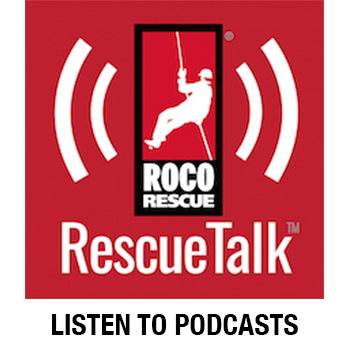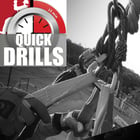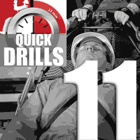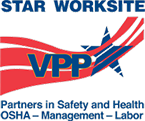 Petzl has reported a couple of instances where cracks may have developed over time in the arms of the ASAP LOCK (B71 ALU). While a cracked arm presents no additional immediate risk to the user, as with any personal protective equipment (PPE), the presence of such a crack requires immediate retirement of the device. In the unlikely event that someone finds an ASAP LOCK displaying cracks, Petzl America will replace these units under their standard product warranty.
Petzl has reported a couple of instances where cracks may have developed over time in the arms of the ASAP LOCK (B71 ALU). While a cracked arm presents no additional immediate risk to the user, as with any personal protective equipment (PPE), the presence of such a crack requires immediate retirement of the device. In the unlikely event that someone finds an ASAP LOCK displaying cracks, Petzl America will replace these units under their standard product warranty.
Roco Rescue

Recent Posts
Inspection Required for Petzl ASAP Lock
Roco QUICK DRILL #11 - Patient Packaging (Single Rescuer)
 One of the skills that separates a good team from a great team is patient handling; how quickly and efficiently a patient can be packaged for movement. Patient packaging and lashing is one area that can save a lot of time during a real rescue. This becomes even more critical when rescuers are wearing SCBA. Good patient packaging skills can significantly reduce the time rescuers and the patient are exposed to hazards.
One of the skills that separates a good team from a great team is patient handling; how quickly and efficiently a patient can be packaged for movement. Patient packaging and lashing is one area that can save a lot of time during a real rescue. This becomes even more critical when rescuers are wearing SCBA. Good patient packaging skills can significantly reduce the time rescuers and the patient are exposed to hazards.
Here's the drill for patient packaging with a single rescuer:
1) Lay out a main line and safety line system with needed materials to attach to a litter for both vertical and horizontal movement as well as for taglines and attendant.
2) Lay out the necessary equipment to lash and build both vertical and horizontal bridles for a given litter. Make sure it is laid out the same way for each participant.
3) Properly place simulated patient/manikin in litter.
4) Tell participant what packaging system is to be built. Example: Sked vertical with attendant or stokes horizontal with taglines.
5) Log the time it takes for each team member to package the patient, build a bridle and make main and safety line connections.
6) Once the team member is finished, inspect the system for accuracy and correct any mistakes. Discuss the technique used and what can be done to decrease the time needed to complete the system. Possible areas to decrease times include: (a) enhancing the individual's skill level; (b) streamlining the order in which the packaging was completed; or (c) considering pre-rig options for the litter to save time during a real rescue.
7) Repeat the drill alternating with vertical and horizontal rigging and the use of tagline and attendants. This drill can also be extended to backboard lashing, short spine immobilizers or webbing hasty harnesses.
Some type of patient packaging is going to be involved in every rescue scenario where a patient needs to be extricated. This could be from a confined space, high angle environment, or low angle/low slope. Being proficient in packaging is critical for rescue efficiency as well as overall patient care. Practice often!
Next in this series: QUICK DRILL #12 Patient Packaging (Tandem Rescuers)
What is a Competent Person?
 Many OSHA standards, especially in construction, require a “competent person” to be designated at the jobsite. Filling this role requires proper training, relevant experience to the work being performed and adequate knowledge of the associated regulations.
Many OSHA standards, especially in construction, require a “competent person” to be designated at the jobsite. Filling this role requires proper training, relevant experience to the work being performed and adequate knowledge of the associated regulations.
The competent person should be able to recognize critical hazards as well as have the authority to take the action needed to mitigate hazards. It’s much more than just picking someone to fill a slot.
A previous article, "What is a Competent Person?" found in the National Safety Council's Safety+Health publication, talks about how the term is often taken too lightly. Again, it's much more than just selecting a body to fill a role or attending one 10-hour training class covering all the various standards. Competency must be considered and evaluated for this important role.
At a minimum, your designated competent person should meet the following minimum qualifications:
(1) A high level of understanding of the types of hazards typically encountered in that area of work;
(2) A solid review of applicable standards relating to that type of work; and,
(3) A thorough understanding of types of solutions to control or eliminate the hazards.
To assist in preparing your competent person in fall protection, we encourage you to register for Roco's Fall Protection Competent Person - April 4-5, 2016 course in Baton Rouge. This course will provide practical experience in recognizing fall hazards and developing appropriate measures for reducing or eliminating those hazards.
New World of Worker Safety: DOL & DOJ Reach Agreement
Source: Safety+Health Magazine February 2016
 Washington – A recent agreement between the Departments of Labor and Justice will launch a “new world of worker safety” by holding managers and supervisors criminally accountable for violations of the law, agency officials announced Dec. 17.
Washington – A recent agreement between the Departments of Labor and Justice will launch a “new world of worker safety” by holding managers and supervisors criminally accountable for violations of the law, agency officials announced Dec. 17.The two departments signed a memorandum of understanding that pools their resources toward the prosecution of individuals who willfully disregard labor and environmental statutes, according to John Cruden, assistant attorney general for the DOJ’s Environment and Natural Resources Division, who spoke at a press conference moments after the memo was signed.
For the past several years, OSHA and DOJ have worked with each other on certain cases, but the new agreement formalizes that relationship.
This cooperation could lead to hefty fines and prison terms for employers and individuals convicted of violating a number of related laws. For example, a roofing contractor recently pleaded guilty to violating an OSHA law, lying to inspectors and attempting to cover up his crime; he could be sentenced up to 25 years in prison.
“Strong criminal sanctions are a powerful tool to ensure employers comply with the law and protect the lives, limbs and lungs of our nation’s workers,” OSHA administrator David Michaels told reporters at the press conference.
Deborah Harris, DOJ’s Environmental Crimes Section chief, said prosecutions would be open to “the ones making the decisions that lead to the deaths of others,” which could include people in the corporate office, as well as managers and supervisors.
Roco QUICK DRILL #10 - Tripod Quick Drill
 Rescue tripods provide a mobile and rapidly deployable high-point anchor option for confined space emergencies. Like any piece of equipment, however, it has its limitations. It is important that your team becomes proficient with this tool in training to ensure fluid deployment during a live rescue.
Rescue tripods provide a mobile and rapidly deployable high-point anchor option for confined space emergencies. Like any piece of equipment, however, it has its limitations. It is important that your team becomes proficient with this tool in training to ensure fluid deployment during a live rescue.
There are two primary topics to review regarding rescue tripod operations: Set-Up and Rigging. Here’s a quick drill to help you and your team become more proficient in its use.
Set-Up
1. Find an area to review your tripod operations. Ideally, train over a potential rescue space, keeping in mind safety around any open spaces. As with any training exercise, always use proper PPE and take proper fall protection precautions. If you don’t have access to potential spaces or are training in a municipal environment, improvise with a closed street manhole or create a mock-up opening with wood or cardboard.
2. Deploy your tripod. While you are deploying it, discuss the following with your team:
a. When do you setup the tripod in a rescue operation? Prior to rescuer entry? During packaging stage? During extrication stage?
b. Do we setup the tripod over the space or in a safe area, then move the tripod over the space?
c. What type of patient packaging will be done and at what height will the tripod need to be in order to clear packaging out of space?
d. Tripod strengths at different height settings. Is height more important or strength?
e. Can the legs of the tripod be different lengths or rest on different elevated surfaces?
f. Should the tripod be tied down so it won’t tip?
g. Keeping resultant forces within the legs of the tripod to prevent tipping.
h. Insure correct assembly, including the use of the tripod’s chain to prevent overspreading the legs of the tripod.
Now that your tripod is assembled, move on to rigging.
Rigging
Rig each of the following systems and raise and lower a load/weight. This shows the pros and cons of operating each system. Show how the resultant forces can be applied by the haul position or by patient movement outside the tripod footprint. In most cases, there are three rigging options for tripod operations. Rig each, while discussing each method’s strengths and weaknesses.
1. Block and Tackle System
a. Often pre-rigged and therefore rapid to deploy.
b. Will the length of the collapsed system create height constraints to remove the victim from the space?
c. Does the height of the tripod create any issues operating the cam of the system?
d. Rope length vs depth of space; what strength M/A will you be able to build?
e. Can the haul team keep resultant haul forces within the legs or footprint of the tripod to prevent tipping, or do we need to have a change of direction pulley?
2. Single Main Line with COD (change of direction) within the Tripod’s Footprint
a. Better option when the tripod’s height and victim clearance are concerns.
b. Enables the lower/haul team to operate remote of the space.
c. Necessitates an anchor point within the tripod’s footprint and an anchor point for the main line.
d. Allows for reaching greater depths than a block and tackle system.
e. Single line entering the space and allows for attachment of patient air bottle.
f. Takes more time to rig.
3. Pass-Through Method
a. A solution when the block and tackle or single main line techniques will not work (no anchor point within footprint of tripod available).
b. Increased Mechanical Advantage (6x1).
c. Requires two remote in-line anchor points on opposite sides of the space.
d. Two traveling lines in the space.
e. Eliminates concerns with haul-resultant forces.
f. Most complicated of the three systems.
A properly deployed rescue tripod can be a game changer for a confined space rescue. As with any piece of equipment, continuous training with the device and its associated techniques is necessary to maintain “proficiency,” which translates into safety and efficiency! Always, train hard so that your team will perform when the call comes!
Next in this series: QUICK DRILL #11 - Patient Packaging (Single Rescuer)
RescueTalk™ (RocoRescue.com) has been created as a free resource for sharing insightful information, news, views and commentary for our students and others who are interested in technical rope rescue. Therefore, we make no representations as to accuracy, completeness, or suitability of any information and are not liable for any errors, omissions, or delays in this information or any losses, injuries, or damages arising from its display or use. All information is provided on an as-is basis. Users and readers are 100% responsible for their own actions in every situation. Information presented on this website in no way replaces proper training!






